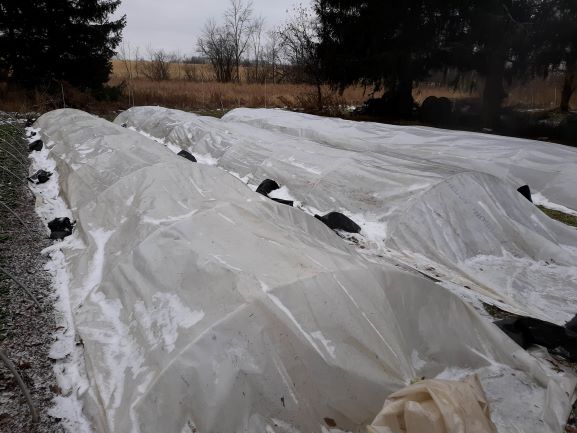 Above: Experimenting with overwintering spinach for spring harvest. It is seeded outdoors in late August. Once it gets really cold it is covered with hoops bent from 10' electrical conduit and a layer of greenhouse plastic- then held in place by sandbags until of course it just freeze to the ground. If all goes well the spinach will start growing again when we come out of our Persephone period-that is when we get more than 10 hours of daylight-something that happens on February 5th at our particular location on this planet we call earth. As December 31st draws near, I am getting ready to send out our first loan installment payments of our community loan project that include principal. We began 2019 with some very ambitious goals. With the funds you contributed, we set out to construct a second hoophouse, and complete a seedling greenhouse so that we would be able to distribute storage and fresh produce to our CSA members for 10 out of the 12 months of the year. Did we accomplish our goal? Yes and no. We were able to construct a second hoophouse and put the finishing touches on a much larger seedling/vegetable curing house. We also invested in irrigation equipment to be able to water our storage crops during the often dry months of July and August. These basic improvements, all funded by the loan project were necessary first steps to get us closer to meeting our goal of launching a spring share.
We got part way in setting up the old barn as an indoor space to pack shares. This space still needs to be insulated and finished-something we hope to work on this winter. One other challenge we need to address is that our current walk-in cooler is not attached to this space and so when temperatures are well below freezing, as they were this fall, we have logistical challenges of moving produce back and forth. We have also outgrown our current walk-in cooler—additional space is needed for our storage crops. Even with 15% losses of crops like carrots and potatoes from flooding this fall, our walk-in cooler was completely full to the ceiling just to satisfy our fall/winter members. In order to address these challenges our plan was and is to put a small attached addition on the barn that would have additional cooler space—we imagined the loan money would cover this and Jeff was ready to go—but supplies and labor for the first part of our project added up quickly and by August it became clear that the loan funds would be spent before we were able to tackle this leg of the project. We try not to make any big decisions in the middle of the season—and so tabled the financing of this portion of the project as something to tackle this winter so that we can continue working on the project during the 2020 growing season and hopefully be ready to launch a spring share by 2021. We do have some extra veggies in storage and are trialing more of Elliot Coleman’s over-wintering strategies this year. While we are not ready to launch shares, we may seek out a farmers market to attend this coming spring and will let you know if we will be in your neighborhood. We are ever so close to meeting our goal and will keep working toward it until it is realized. -Kelly
2 Comments
Leave a Reply. |
Archives
December 2019
Categories |
 RSS Feed
RSS Feed